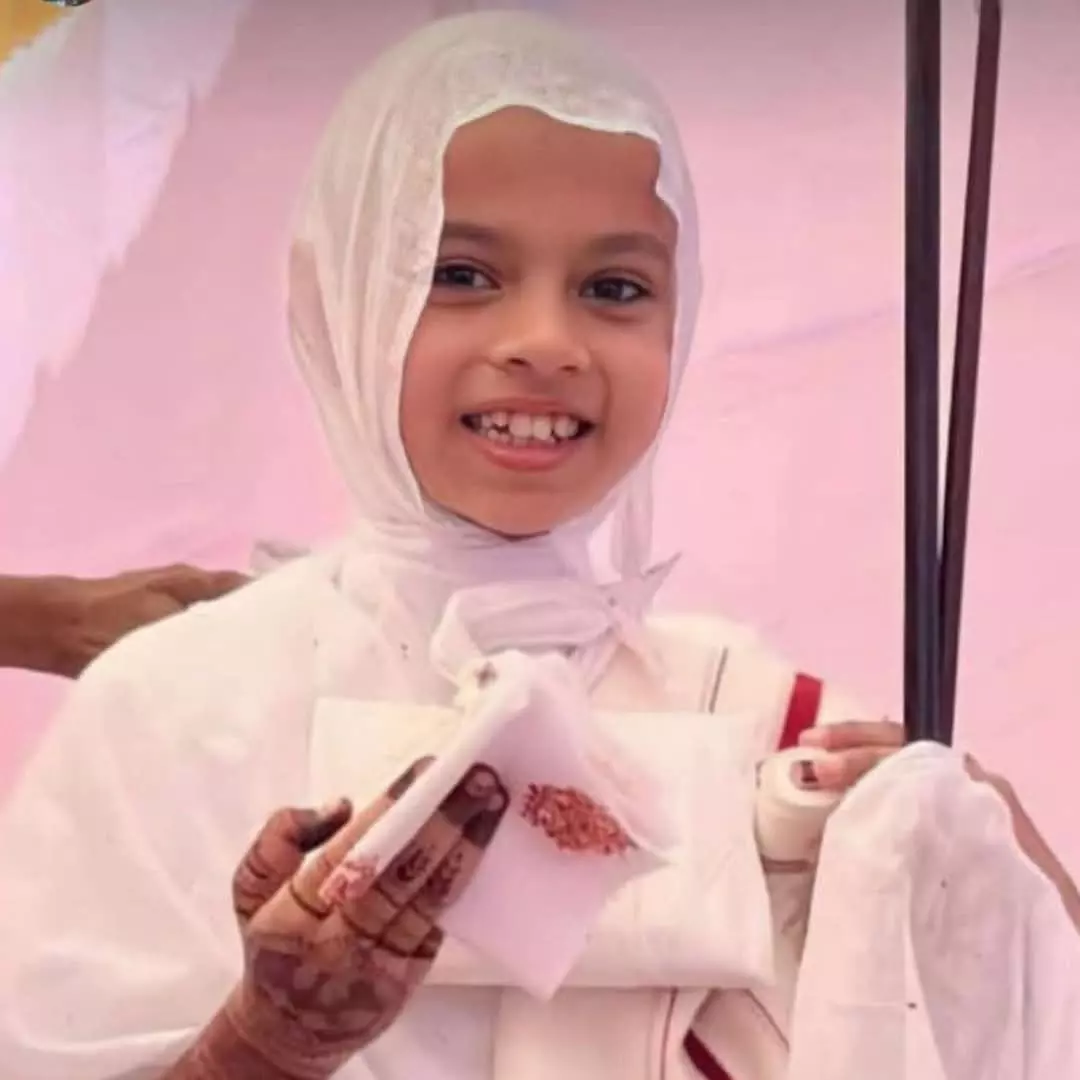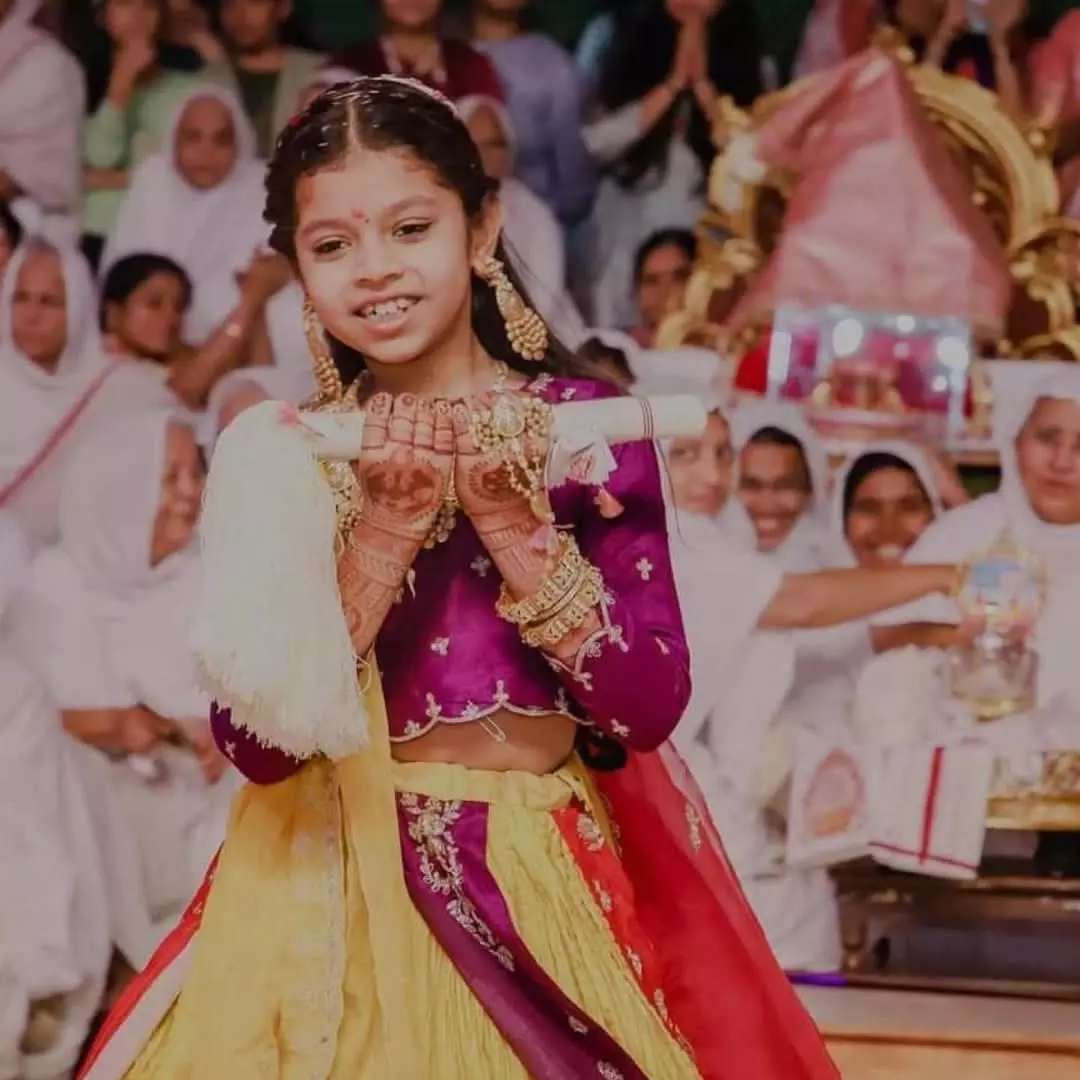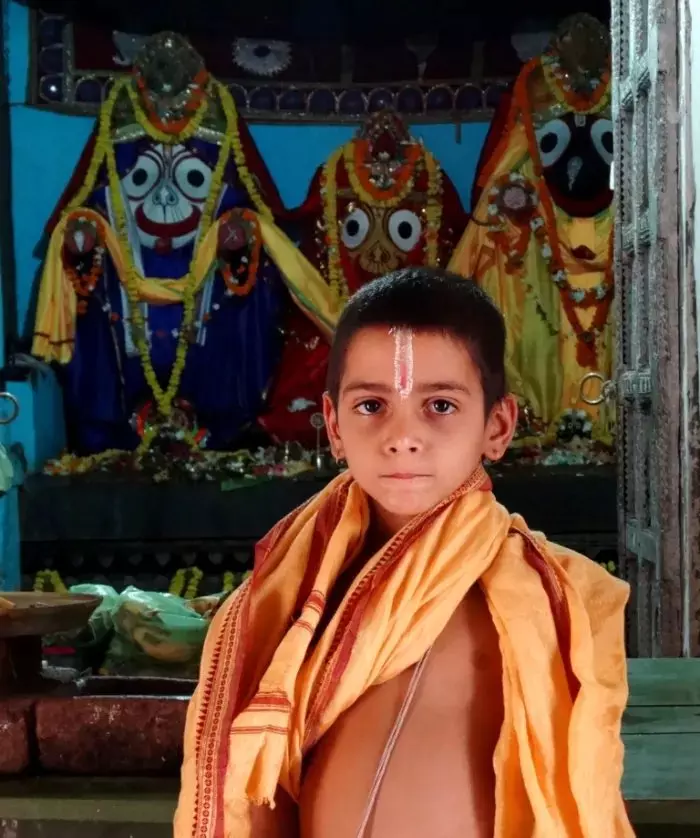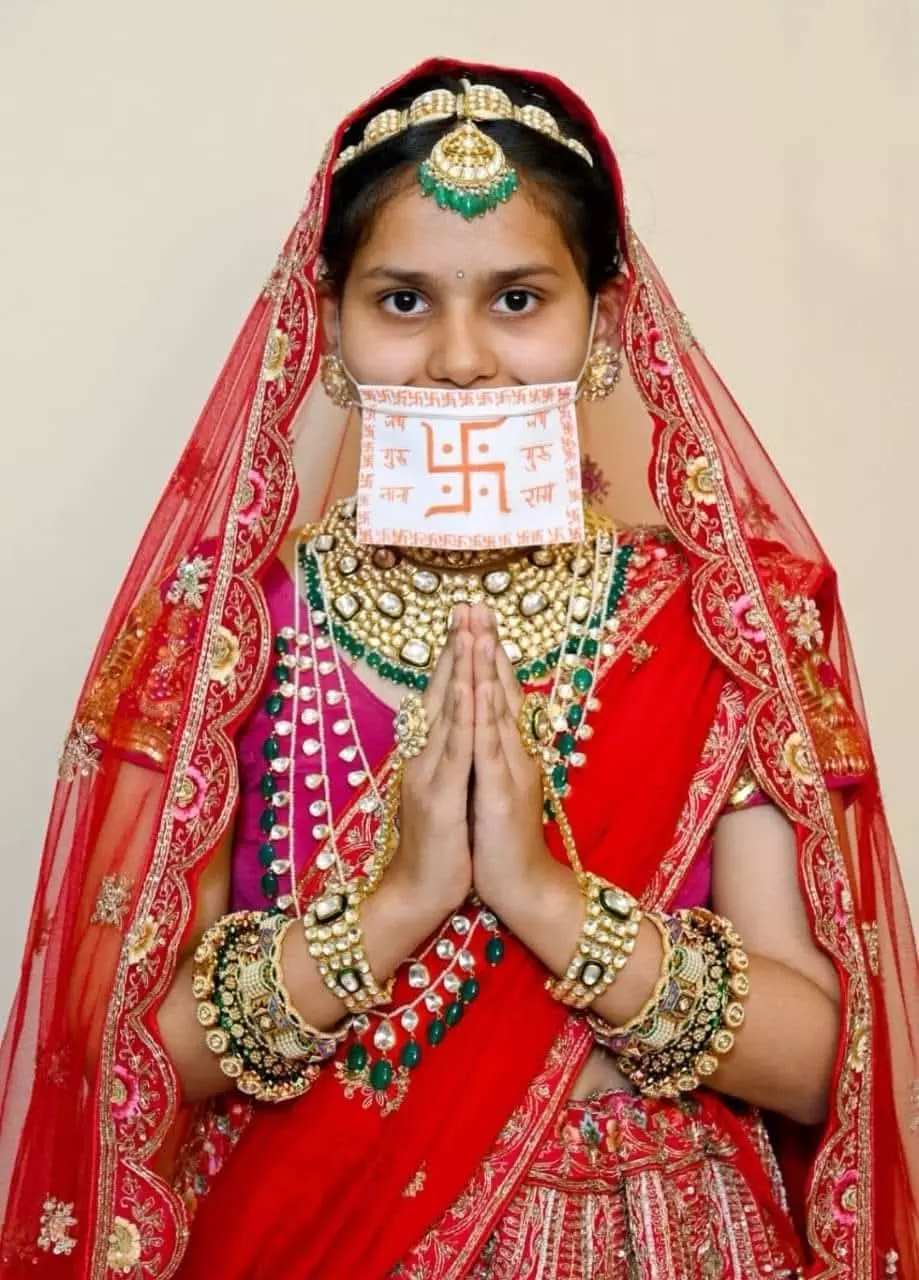
- Home
- India
- World
- Premium
- THE FEDERAL SPECIAL
- Analysis
- States
- Perspective
- Videos
- Sports
- Education
- Entertainment
- Elections
- Features
- Health
- Business
- Series
- In memoriam: Sheikh Mujibur Rahman
- Bishnoi's Men
- NEET TANGLE
- Economy Series
- Earth Day
- Kashmir’s Frozen Turbulence
- India@75
- The legend of Ramjanmabhoomi
- Liberalisation@30
- How to tame a dragon
- Celebrating biodiversity
- Farm Matters
- 50 days of solitude
- Bringing Migrants Home
- Budget 2020
- Jharkhand Votes
- The Federal Investigates
- The Federal Impact
- Vanishing Sand
- Gandhi @ 150
- Andhra Today
- Field report
- Operation Gulmarg
- Pandemic @1 Mn in India
- The Federal Year-End
- The Zero Year
- Science
- Brand studio
- Newsletter
- Elections 2024
- Events
Why parents of child monks are losing the battle for their own children

Shivani Gajera (name changed), a 35-year-old house wife of a textile trader in Surat, quietly takes a tiny pink piece of cloth and a photo out of her wardrobe. She gazes hard at the photo and reluctantly puts it back before anyone in the family sees her.“I have only one photo of her that was clicked hours after she was born. This pink cloth is from the hospital. They had blue cloth for boys...
Shivani Gajera (name changed), a 35-year-old house wife of a textile trader in Surat, quietly takes a tiny pink piece of cloth and a photo out of her wardrobe. She gazes hard at the photo and reluctantly puts it back before anyone in the family sees her.
“I have only one photo of her that was clicked hours after she was born. This pink cloth is from the hospital. They had blue cloth for boys and pink for newborn girls. I couldn’t bring myself to thow away the photo and the cloth although the ritual dictates otherwise. My family doesn’t know I still have them,” says Shivani, breaking down as she recalls her one-and-a-half-month-old daughter who was given away to become a Jain monk.

Devangshi, daughter of a Surat-based diamond merchant, took bal diksha in 2023 at the age of eight years.
“I would have named her Prerna but she never got a naming ceremony. My in-laws decided that we should not name her as she is destined to become a monk. I am not allowed to talk about her in the house. My husband says I need to let go as it’s been two years now. I try to keep busy with my second-born child and my family but there are days I can’t help wonder where she is and how she is,” the mother adds.
Shivani was married to a family of wealthy textile businessmen in Surat in 2015. The family owned 10 textile mills and business had been going well until 2017 when GST tax regime was implemented by the Narendra Modi-led Union government. Like every textile trader of Surat, the Gajera’s suffered immense losses and couldn’t recover. Shivani’s father-in-law, the head of the Jain family, took suggestion from Nageshwar Parshwanath Derasar, the family’s place of worship for generations.
“The Acharya (head monk) suggested our family should donate the first-born of the family to the derasar to become a monk to end the bad luck. I cried and requested a lot but the decision was made and no one heard me in the family. Even my own parents suggested that I should not do anything against what the Acharya suggested,” tells Shivani, whose daughter became the youngest Jain monk in the country in 2022 at the age of just one and half months.

Devangshi on the day of her bal diksha with arohan, the white broom in her hand symbolising initiation into monkhood.
“My daughter is now Mata Kanakprabha Shrijee. That’s all I know about my little girl,” she says.
Shivani isn’t the only parent who has unwillingly lost her child to bal diksha, a religious process that inducts children into monkhood, leaving behind their material world.
***
In May 2024, Praveenbhai Sojitra, an income tax officer from Sarthana in Surat, filed an FIR of missing person for his 17-year-old son Dhruv Sojitra.
“My son was brainwashed and coerced into becoming a monk instead of completing his studies by the monks of Vadtal Swaminarayan sect,” Praveen Sojitra tells The Federal.
“My family came into contact with the sect a year ago. After a few months, my son began to visit the temple alone and he was inducted into monkhood through a ritual called tilak haar without telling us. After the ritual, they shaved his head and gave my son white cloths to wear. Dhruv left home after that and we were told our son is renouncing the material world including his family. We were shocked. He is our only son and we had no inkling that he was being brainwashed. My wife Reena was inconsolable and we begged Dhruv to come back to his home. But he refused to even recognise us. Despite several attempts to get him back we couldn’t and so we filed an FIR,” adds Sojitra who claims that police have not done much since he filed the complaint last year.
“They (police) say the investigation is underway. I think they are wasting time as it goes in favour of the monks. In two months, Dhruv will turn 18 and then I don’t know if we will ever get him back. Reena has been unwell since he left. He was a good student and wanted to become a scientist you know,” sighs Praveenbhai.
“Reena has mostly been bedridden since Dhruv left. She sleeps all day and hardly speaks. When she does, she only asks if Dhruv is back,” he adds.
About 350 kilometres away from Surat, Ashok Shingala’s wife Mukti also waits for her 16-year-old son to return home.
***
It’s been a year since Singhala, a 43-year-old man and a farmer from Gir Gadhara in Gir Somnath district, had filed an FIR against Janardan Swami of the Swaminarayan Gurukul accusing him of brainwashing his son into joining monkhood.
“My son Shivas was a student in a school run by Swaminarayan Gurukul in Gir Gadhara. He was an average student but good in sports. He wanted to play cricket when he grew up. He used to dream of being enrolled in Saurashtra Cricket Academy in Rajkot and be a professional cricketer. Now, he has been made to give up his dreams, his studies and his whole life ahead of him,” says an angry Ashok Singhala.
“One day we found a notebook in his bag with questions regarding monkhood. When he asked him about it, he said he wanted to become a monk. Mukti broke down just hearing that. I scolded him and asked him to focus on his studies. A month later we found him watching a video on mobile where Janardan Swami was preaching children to quit eating if their respective parents did not let them go on to become monks,” Mukti says.

Bal muni at Swaminarayan temple in Gir Somnath. His parents had filed an FIR to get him back but in vain.
“That day we realised Shivas was adamant on becoming a monk. He would stop eating if we did not let him go. A week later, he came home with a monk from the Gurukul and told us that he was getting inducted the same day. We helplessly sat at the bal diksha ritual where they made him throw his books, his clothes, his cricket bat. Shivas then wore a white cloth and his hair was plucked one by one till he was bald,” she says breaking down.
Janardhan Swami, however, denied the allegations leveled by the family.
“The child has been inducted into a process of becoming a monk. It takes 10 years to become a monk. Besides, the child has reconciled with the family and they are now okay with him completing the process to become a monk. Until then he will be living at at an upasraye (place where monks temporarily reside during their road journeys) and will pray for hours and repent if he has a bad dream, walk barefoot, eat sparsely, remain celibate and have his hair plucked out (kesh loch) twice a year. He will also require to break all family ties. If their parents want to meet them, they have to visit like other devotees only when he is travelling on road,” said Janardan Swami.
“Sending a child to become a monk is like sending a child to a higher school. Only children who can think clearly and have made up their mind are taken into bal diksha,” he said.
Bal diksha and child rights
Shersingh Rajpurohit, a retired army personnel approached the Gujarat High Court last week, seeking the return of his missing 12-year-old daughter who he claimed had been under the influence of priests from the ISKCON (International Society for Krishna Consciousness) temple in Ahmedabad.

Rajpurohit's daughter from the day she decided to be a monk.
“My daughter’s life is in danger. She is just 12 and cannot make such life changing decisions. It is her right to be educated first,” says Rajpurohit.
During the hearing of the habeas corpus petition, Rajpurohit claimed that his daughter had been regularly visiting the ISKCON temple for worship and prayers for past few months.
“During her visits, she came into contact with certain priests at the temple who brainwashed her and now my 12-year-old daughter wants to become a Sadhvi,” adds he adds.
Following the petition, the High Court directed the state government, Ahmedabad police commissioner, and the ISKCON authorities including Nilesh Deshwani, Sundar Mama Prabhu, Murli Prabhu, Nardmuni (also known as Nirmoi Murli Manohar Prabhu), Ankita Sindhi, Harishankardaras Maharaj, Akshaytithi Kumari, Mohit Prabhujji Maharaj, and others, to respond to the petition on January 7.
However, the habeus corpus petition was thrown out on January 7 after the authorities of ISKON appeared before court with the girl stating she is safe and has decided to undergo bal diksha.
This isn’t the first time the judiciary has decided in favour of a religious institution in cases against bal diksha.
In 2004, when nine-year-old Priyal Bagericha, a resident of Pune became a Jain Sadhvi, Bal Prafulta, a Mumbai-based child welfare NGO received a complaint that Priyal was running high fever and was being forcibly inducted.
A petition was filed by senior lawyer Ravindra Parekh on behalf of the NGO in a family court in which he sought Priyal's custody.
“The Malad Police expressed helplessness when contacted, saying that bal diksha was not illegal. So, we decided to hire a lawyer and claim her guardianship. Her father was a clerk at a government office and his income should have been enough for the family of four. But the mother of the child was suffering from a chronic disease and the family was struggling financially with all income going into the treatment of the mother. So, we decided to legally adopt Priyal and give her education and life that is the right of every child,” said Santosh Shinde, the project director of the organisation who handled the case in 2004.
Shinde, with another organization, Childline, then approached the Child Welfare Committee (CWC), a state government body that looks over child rights. The CWC issued a notice to the Jain Sangh for violation of child rights under the amended Juvenile Justice Act of 2000 (JJ Act).
“However, the lawyer representing the Sangh stated that CWC’s claims were misplaced and none of the nine clauses of JJ Act that define a child in need of care and protection applies to Priyal as there is ample evidence that Priyal’s parents have agreed to her will to become a Sadhvi. We eventually lost the case,” he added.
“As per our survey conducted in 2010, about 400 to 500 Hindus and about 100 Jains get ordained as monks every year as monks across the country. Ten percent of them are children,” adds Shinde.
Noticeably, several child rights organisations in multiple states have many a times attempted to stop the practice of bal diksha claiming it went against child rights. However, in all cases the rulings have been in favour of the religious institutions.
Jain Yuvak Sangh of Bombay, one of the oldest child rights organization in the country, which advocates against bal diksha within Jain community has been carrying out sustained campaigns for years asking parents to not sent their children away to become monks.
“There have been repeated attempts since 1955 to get a legislative bill passed in Parliament against bal diksha. Between 1990 and 2000, we had made relentless campaigns among the Jain community, especially the Shvetambara sect with the Bala Diksha Pratibandha Andolan (Prevention of Child Initiation Movement). It had its impact for some years but then we started facing pushbacks from the Jain derasars and various other Hindu sects. In 2008, in one such case that we fought against a Jain derasar of Gujarat, the Bombay High Court had observed that no religion can allow a minor to become a sadhu. It’s as bad as Sati and there should be some law to prevent minors from taking diksha. But that was later ruled over by the Supreme Court and we still do not have a law against bal diskha,” says Harshil, one of the coordinators of the organisation.
In 2009, the Women and Child Development department in Delhi issued a notification that bal diksha shall not fall under the purview of Juvenile Justice Act 2000.
“Since then, the ritual has been conducted unabated,” shares Harshil.
“So far there has not been a single precedence where the court has ruled against bal diksha even in cases where parents themselves have filed the cases seeking back their children. In 2009, a Jain monk Kirtiyash Surishwarji Maharaj faced charges for issuing a bogus notification stipulating bal diksha was approved by the Central government. But later he got bail from a local court in Ahmedabad. In 2012, the Bombay High Court ruled that the widely contested arguments around Jain Bal Diksha is a complex matter which will have wider ramifications and ruled that the ritual cannot come under the JJ Act as it would then hurt right to religious freedom. In 2022, Gujarat High Court had dropped all charges against six monks of Swaminarayan sect after the parents had filed an FIR leading to a habeus corpus case to get back their 11-year-old daughter,” he adds.
